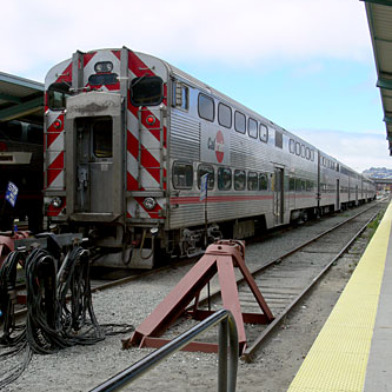 With one-time funding sources for Caltrain expected to run out by the end of fiscal year 2013, the Caltrain board of directors today considered a preliminary budget that would add trains to its current weekday schedule, and approved an agreement with the California High-Speed Rail Authority to provide $1.5 billion to electrify the corridor.
With one-time funding sources for Caltrain expected to run out by the end of fiscal year 2013, the Caltrain board of directors today considered a preliminary budget that would add trains to its current weekday schedule, and approved an agreement with the California High-Speed Rail Authority to provide $1.5 billion to electrify the corridor.
Caltrain Deputy CEO Gigi Harrington said that average weekday ridership has increased for 20 straight months to reach historic highs, up 12 percent from this time last year.
Some trains at peak commute hours have more passengers than seats, Harrington said.
The fiscal year 2012-2013 preliminary budget includes a $375,000 investment in six additional weekday trains that will help relieve overcrowding at peak hours.
However, the one-time grants, savings, and fare-box revenue increases that have funded Caltrain from year to year are drying up, Harrington said.
Caltrain’s executive director Mike Scanlon said that Caltrain had not solved its fiscal crisis, just delayed it for another year.
In a separate vote that Scanlon referred to as “historic,” the board of directors unanimously approved a memorandum of understanding with the California High-Speed Rail Authority to match more than $700 million in funds from the Metropolitan Transportation Commission to electrify the Caltrain corridor between San Francisco and San Jose, and pave the way for a two-track right-of-way that will eventually accommodate high-speed trains.
Board President Adrienne Tissier, who also chairs the MTC, received a warm round of applause from board members and the public for her “Herculean” effort in spearheading negotiations that secured the funds for a “long overdue” Caltrain upgrade.
“It was a very bumpy road at the beginning,” Tissier said.
Tissier commended the CHSRA for listening to the concerns of Peninsula cities and residents along the right-of-way, and coming up with an agreement that would free up high-speed rail funds to electrify Caltrain, which will ultimately be able to operate on a track system that blends with high-speed rail.
“Without this start, this foundation, we have nothing,” Tissier said.
An electrified, upgraded Caltrain will be able to make more stops, accommodate more passengers, and reduce greenhouse gas emission by running on electricity rather than diesel-powered engines.
If started this year, the electrification project could be completed by 2015.
The $1.5 billion agreement has already been approved by the MTC and the CHSRA.
The funding will now need to be approved by the state legislature.
Chris Cooney, Bay City News
Want more news, sent to your inbox every day? Then how about subscribing to our email newsletter? Here’s why we think you should. Come on, give it a try.









